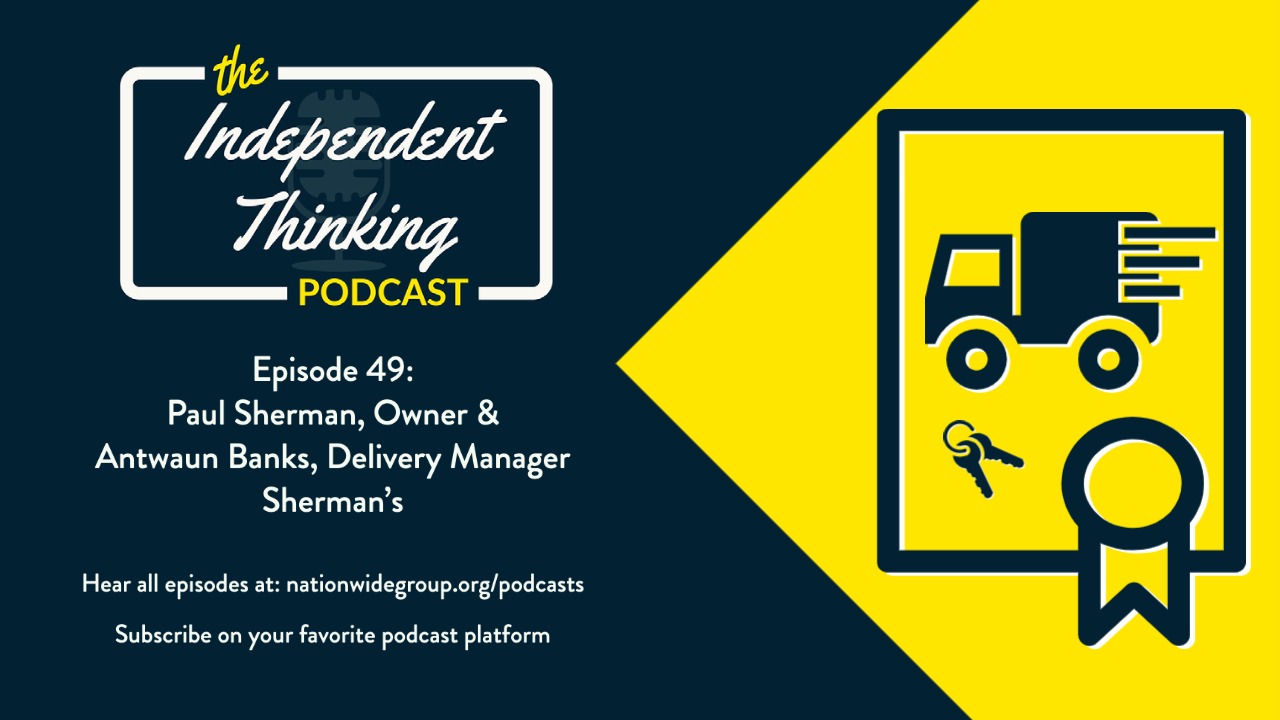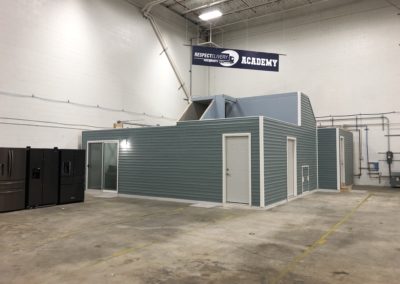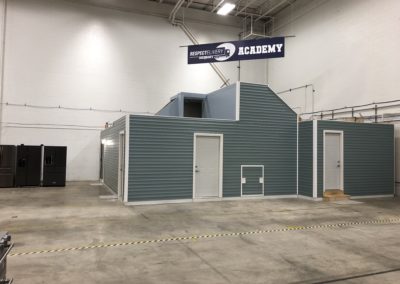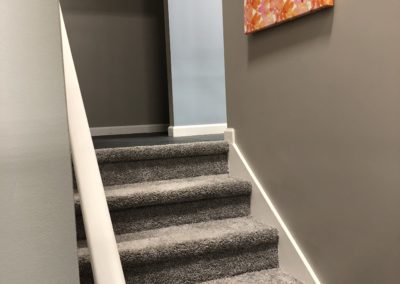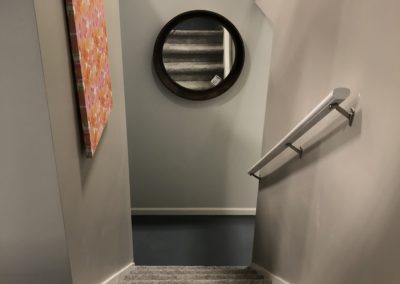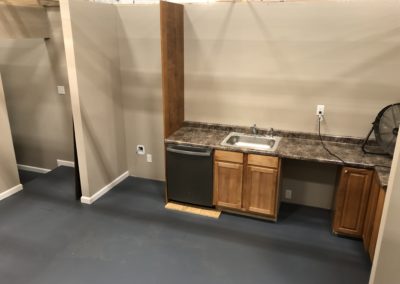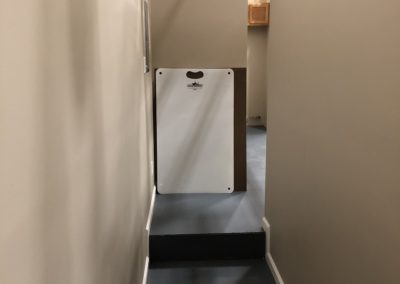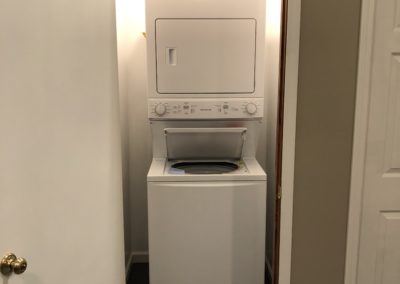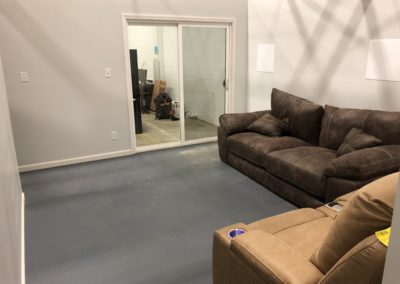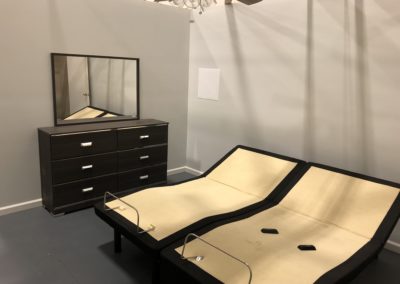For most appliance and furniture delivery teams, training is baptism by fire. But for Sherman’s in Peoria, Illinois, their custom-built obstacle course — that’s literally a functioning home — is where they’ll complete an 80-hour training regimen before heading out on their first job. Paul Sherman, CEO and Owner of Sherman’s, and Antwaun Banks, delivery manager, share their experience building and training staff in the home. Below are some of images of the home, along with a promotional video that Sherman’s created that details for customers the training process Sherman puts its delivery team through.
Rob Stott: All right. We are back on the Independent Thinking Podcast, and really got an interesting one for us today. Been looking forward to diving into this. And first of all, Paul Sherman’s up there in Peoria, Illinois. Appreciate, first of all, you joining us and dragging along Antwaun Banks, delivery manager there at Sherman. So you know it’s going to be a good one when we got more than just a one on one. So I appreciate you guys having time and stopping your day a little bit and chatting with us here on the Independent Thinking Podcast.
Paul Sherman: Yeah, happy to do it.
Antwaun Banks: Yeah, great opportunity, thanks.
Rob Stott: Yeah, you bet. So before we dive into it, and for those who’ve read the headline, they know what’s coming. But before we get into this house, Paul and Antwaun, I want to talk to you guys about your path through retail. We’ll start, Paul, with you. Talk a little bit about Sherman’s, and how Sherman’s came to be, and your path to being CEO and owner there.
Paul Sherman: Sure. Yeah, absolutely. So actually, Sherman’s was founded in 1976 when my dad, who was a lineman for the local utility, decided to open a little one-room shop selling Litton microwaves and Amsoil and gifts and an eclectic little mix. Mom ran it for a year, and then he decided to quit his job and roll with it. So he started in ’77 expanding into appliances, eventually getting into electronics and bedding and furniture over the years. He expanded to several different marketplaces. And then when I got out of school, went to work for one of our suppliers for a few years, realized, “You know what? Probably better to go join dad’s company, maybe.”
And did that. Have done just about every job in the company, working my way back up. And it’s been really fun. So been at the helm for quite a while, since the ’90s. We’ve expanded quite a bit. And today we have four locations throughout central Illinois. And primarily appliances is the category we’re number one market share in. But we have a really substantial furniture and bedding business as well.
Rob Stott: Ah, that’s awesome. So you guys kind of run the gambit for what Nationwide has to offer as far as product categories and things like that. What’s the thing that you think, in your words, makes Sherman’s stand apart from others in your market, as far as retail’s concerned?
Paul Sherman: Well, there’s a lot of benefits of being a locally owned chain, like a lot of Nationwide dealers have. There’s just a care and a camaraderie in the teamwork and the concern for the customer that’s kind of at a different level. Also, the department Antwaun runs is a little more critical to our success than I think the delivery department in a lot of different companies. We certainly, like a lot of places, carry heavy inventory. But we also are super committed to next day delivery seven days a week.
So it doesn’t matter if you come in at 5:30 at night, you’re getting your new washer delivered the next day. Tomorrow, as we like to mispronounce it. It takes a lot of resources to be able to do that, to never shut deliveries off for the next day no matter how they get. But Antwaun and team tend to pull that off. Can’t tell you how many times I’ve been stopped out in the community, say, “Man, Paul, I can’t believe… Man, you really saved us, man. The washing machine was out, had to get the laundry done for the kids on Sunday. And came in Saturday night or ordered online, and Sunday it was up and running by one o’clock.”
So we get a lot of that sort of thing. That’s probably one of the single biggest differentiators, I think, that has gotten us to the number one market share position in appliances.
Rob Stott: No, that’s awesome. And no pressure on you, Antwaun, right?
Antwaun Banks: Yeah, none at all.
Rob Stott: Talk about your path to Sherman’s and what made you want to join a company like this and be working with someone like Paul.
Antwaun Banks: Yeah, it’s a great opportunity. I started working here, and I started out as a delivery driver. And then I started looking around, there’s so much opportunity here. I was blessed to become a driver mentor, which led into me being assistant delivery manager. And then where I stand now is delivery manager. A kind of fun fact, when Paul was speaking on Jack, when he was a lineman, my dad was actually his assistant foreman. And now Paul is like my mentor, and I work for him. So that’s a great fun fact. Great place to work. I’ve learned a lot. Mentor well. And I just look forward to continue to grow with the company.
But being delivery manager does have its ups and downs with it, but we move forward and keep changing and moving the needle forward.
Rob Stott: Oh, that’s awesome to hear. And cool little back story. That’s a neat tie to the history of you guys. So neat to see it weave into today’s iteration of Sherman’s.
Antwaun Banks: Yes.
Rob Stott: So I know the last year’s been kind of challenging, and I think specifically, from a delivery standpoint, I’m sure. As you can probably both attest to. Question to both of you, and Antwaun, maybe you can start, the impact of COVID on your day to day. What’s that been like for you over these past 10 months?
Antwaun Banks: Well, it’s been an everlasting up and down roller coaster. Like a lot of us. Different changes with us going into the customers’ home and being around close quarters, we have to make sure that we have the right things in place as far as Virex hand sanitizer, masking, disinfecting of the trucks. And in the beginning it was quite challenging because things were changing by the day. So we just rolled with the punches and got through that point, and now things are a little bit more consistent, but they still change. But we just do our best to try to ensure the safety of the customer and our employees, as well.
Rob Stott: Absolutely, and Paul, I know that Antwaun mentions the safety of the customer. Obviously it has a big impact on the delivery side.
Paul Sherman: Certainly.
Rob Stott: But what about for broader view of Sherman’s? What sort of impact have you guys had, and how have you been managing these past 10 months?
Paul Sherman: It’s one of those things that falls under the heading of if it doesn’t kill you it makes you stronger. There’s been a lot of positive things long term that’s come out of this. We dramatically improved our online presence last fall, so when this thing hit we had already a dedicated person to internet, and we were able to quickly expand that team and keep going through even the shutdown period of it. We’ve certainly learned a lot of new ways to communicate with guests. We never used to just walk around on the floor in video chat selling to somebody at home. That wasn’t a thing. So we had to change a lot of procedures that way.
But internally, one of the first things that we decided we had to do was I had to be out there every day making sure, trying to put people’s minds at ease and communicate what we knew when most of us didn’t know a lot of different things. So a lot of the communication, my weekly update video to the company or our weekly Tuesday check-in call for the extended management team. These type of things really brought us closer together. And a lot of that communication, I think, has improved greatly, even though this is not as good as being in person.
What we’re learning, though, is we can do this more frequently and still be really in tune with one another. Now, of course, Antwaun doesn’t have that benefit, right? He and his guys got to get down there on the floor, load the product, and go out in people’s homes. That was its own unique management challenge to begin with because you just got a lot of uncertainty. You know? We’re essential, we got to keep rolling. People wanted to work. But then they were very nervous about doing that. So until we got to where we are today, where we know what we’ve got, here’s the sanitization procedures, here’s the mask protocol and all that sort of thing, it was rough. But it’s good to see the vaccine’s on the horizon. I’ll tell you that.
Rob Stott: As we’re sitting here, it’s getting closer. It feels like the light is at the end of that tunnel, and it’s real now.
Paul Sherman: Just a little bit. Yeah.
Rob Stott: There’s a little sliver of it, but it’s real now, and we’re getting there. But you talk about the impacts and changes on delivery specifically, and getting into customers’ homes. COVID aside, I know that maybe it might have been just a couple of months into the pandemic and all these changes that you guys actually had another big delivery adjustment, and that’s kind of why we’re here talking today. And that’s this house that we really need to dive into, because what a unique concept. And for those that don’t know, I know you guys have videos that we’ll be sharing on the YouTube channel, if you’re watching this, and underneath if you’re on the Nationwide site.
This house is, at its core, it’s a training tool for your delivery team. But it’s not just plywood in a warehouse, couple of sheets put up and that’s it, and trying to work around. It is… When we say a house, from what I understand, it is a house. It’s a working house. Could someone live in this house?
Paul Sherman: Just about. I think so. You could get a bed in there. It’s got plumbing and electricity and everything else. All the connections for whatever appliances you want to put in there.
Rob Stott: So you got to be careful that way. Make sure employees end up sleeping overnight or something like that in this house. But no. So tell me, Paul, where does this start? Where does the idea for this start, and what was it like getting everything up and moving into this house?
Paul Sherman: Yeah. Well, it started, Antwaun, in trying to improve training, had requested that we get a few of the most popular appliances in a corner of the warehouse and a couple of props. Maybe a doorway and a few stairs, just so you could do a little training on it. You know? And I distinctly remember saying, “Yeah, I think we should put something like that together. No problem.” I said, “I’m not going to build you a house or anything, but…”
Rob Stott: Hold on. So you-
Paul Sherman: Actually, that was my…
Rob Stott: This wasn’t supposed to happen.
Paul Sherman: No, it was not supposed to happen. But then what Antwaun started, then we went out and we said, “Okay, what do you guys really need? What do you need to train with?” And then, of course, you get back, “Yeah, we need a doorway to go through. Maybe a bigger one and a smaller one. Maybe one with a stair, simulating coming in from the garage. And we certainly need gas and water connections, different types of gas and water. We should probably show copper gas pipe, what you don’t connect to, too. And we need the stack laundry and side by side laundry, and a dishwasher simulated where somebody put a floor in front of it to make it harder. And a ceiling fan that’s low. And pictures on the wall.” You see where I’m going, right?
Rob Stott: You’re kind of describing a house.
Paul Sherman: Yes. We’re describing a house. So when you ask everybody on the team, “What do you need to properly train your folks?” The only answer became to build a house. And at first, of course, we thought that absurd. But then when you really think about it, okay, how are we training people? Well, how does anybody train people?
Rob Stott: Right. And the question that this begs is without having a house to train in, what is… Maybe, Antwaun, this is something you can tackle. How do you train a team to deliver in a house? Is it literally the way you train is by going into people’s homes? Or is there anything you can do when you’re not on an actual delivery to train?
Antwaun Banks: Yes, well, we usually used to start with showing how to take fridges apart, put cords on. The day to day regimen of what you’ll be going through. And then we had the tough task of you have to do that real time in front of a customer who you’re trying to satisfy at the same time, which poses a lot of challenges. Customer’s watching, you’re trying to learn. It frustrates the new guy if he makes a mistake right there. Plus, you could possibly damage the customer’s home and some of Sherman’s reputation in the process.
So it was tough. And we tried to do it, and you can definitely see the difference in us being able to have a more specialized crew out there, and the customer doesn’t have to watch us in the process of training.
Rob Stott: You kind of hit the nail on the head. Well, you don’t hit the nail on the head, I guess is one way to look at it, because you’re not damaging anything anymore. But it kind of, I guess, Paul, in their firsthand experience of the types of challenges they face, that kind of input, as far as designing something like this, has to go a long way to make sure… It’s not like they’re going into this training now, this house that you guys have… It’s got to be some of the most challenging things, I imagine. It’s not just basic sort of things that they would… You’re trying to trip them up, I guess, is my point, with this house.
Paul Sherman: Oh, it’s an obstacle course. Oh, absolutely. It’s all designed to be some of the most difficult stuff you could do. But what’s amazing about it now is when they come off that training, basically everybody, if you’re going to be a driver, before you get your keys, you got to go through an 80 hour, 13 point certification process. But when they’re done with that, the confidence level they are starting with when they walk into their first home’s amazing versus all of those challenging situations. How do you take a sofa up into a split-level home and up around a staircase. Right?
Any of these different things. Or how do you connect that particular kind of appliance we don’t see all the time? They’ve already been through it. They’ve seen that stuff, and they don’t have to wait until you run into that situation four months down the road and hope you’re with somebody who’s actually still training you. Right?
Rob Stott: Right.
Paul Sherman: And so they get all that confidence before they ever go out and do their first delivery. It’s really night and day.
Rob Stott: So what’s the process that you’re determining, “All right, well the only thing we can do here is build a home.” So you’ve now made that, Antwaun and his team have convinced you that the home is the way to go. What’s the process like pulling something like… How do you find the space for that, and what was it like to actually build this home?
Paul Sherman: Well, one thing we’re blessed with is our distribution center is about 80,000 square feet at ground level. But we have a 50,000 square foot room above the 30 foot clear room. It’s two 30 foot clear levels. Used to be a Pabst brewery, actually a bottling facility. So they’d run product up and down. So I’ve got this 50,000 square foot room up above that’s very hard to store product on. So, in other words, we have extra space. So that’s where we put it up there. So for us, the space wasn’t an issue. I know for a lot of folks, 1,100 square feet isn’t… You’re just going to have, probably, 2,000 square feet by the time you take the product available sitting outside the home and that kind of thing. I know not everybody has that.
So we had the space. We also had phenomenal in-house maintenance guys. So Joe Patterson, who’s our project and maintenance manager, was able to actually lay out the whole thing in collaboration with everybody in the company of what they want. So he did all the design work, supply sourcing and all of that. And so our internal team built the whole thing.
Rob Stott: Wow.
Paul Sherman: We’ve got guys that can do electrical, and the plumbing, and the construction and all that kind of thing.
Rob Stott: So now, with the finished piece, is it something that you guys can customize moving forward? Or is this, if you were going to do a home renovation, you’d have to renovate this home.
Paul Sherman: Yeah, hey, we can always do an addition, right? Yeah, we can certainly alter it if we need to. We’re really happy with how it’s worked out. Taking the first dozen or people through it that Antwaun has, I think it’s worked out good, hasn’t it?
Antwaun Banks: Yes, sir, it’s definitely worked out well. And we always had the driver and helper mentors that we used to use for the training that we spoke of earlier. But now it makes their job a little bit less strenuous, and it’s kind of just like the fine tuning and the last finishing touches. You know? You take them out, you make sure they know everything and can keep everything that we gave them upstairs, and you still have that extra lining of the last minute training, which makes it, we have better success rate as a result of that.
Rob Stott: No, absolutely. And you talk about success rate. The types of things that you’re walking through as you go through this house, it’s not only carrying appliances and furniture through a home. There’s kind of that peace of mind, I guess, as you’re training, that if something were to happen, yes, it’s training, you don’t want it to happen. But it’s kind of your guys’ home that any damage to the training course is something that you guys can fix and it’s not, like you mentioned, something that comes back on, reflects on you guys in training. So you kind of get that out of the way.
But it also sounds like, too, so it goes beyond just the carrying around the home. It’s actually hooking it up and installing some of the appliances as well. Is that right?
Antwaun Banks: Yes, sir. It’s the hooking up of the appliances. It’s a lot of the 29 inch doors that you see in the older homes. You got your slide patio doors with the outside lights. Like Paul was saying earlier, you got your ceiling fan, your adjustable bases, anything that you can think of you might have to get around it in the home, it’s there. And it’s such a real life situation that everything in there, we have it fixed where it can be easily fixed, but it gives you the real life feel of making the damage if you do. And it gives us the chance to correct that action so that it doesn’t happen in the field when it’s most important.
Paul Sherman: And to your point, Rob, the floors in this are basically painted Masonite. And so if you do everything perfectly, the paint stays nice. If you scratch the paint, well, that was the equivalent of scratching a wood floor. Well, it’s no big deal when you’ve got somebody put an appliance down, scoot it, “Okay, you just scratched the floor. We have to repaint it.” In the customer’s house you would have just caused a several thousand dollar wood finish job.
Rob Stott: Yeah.
Paul Sherman: For them to screw it up right here when we can get a bucket of paint out and paint over it, that’s the entire objective. Right? Of letting them experience that and mess up there. Not in front of that customer in their house.
Rob Stott: Right. And that, too, obviously something like this, you know it’s got to be… You guys invested in training, and that’s something that can’t be understated. But you talk about the payoff on the other side is that you aren’t having those damages in customers’ homes where, at a certain point, the benefit of this… There’s almost a return on investment of building this home for you guys.
Paul Sherman: Well, two sides. Well, multiple angles. The hard cost side, it will pay for itself very quickly in less damages. But we also put together a promotional video for our salespeople to use. So when somebody asks, “They’re doing free delivery, why should I pay for your delivery?” “I’ll show you in 90 seconds. Watch this video. You want guys trained at this level. You don’t want guys just without training messing your house up.”
So our delivery revenue is going up also because we’re able to demonstrate the superiority of our delivery service. And so our salespeople are much more confident in it and they sell the service at a higher level. So you’ve got the cost reduction and the delivery revenue increase. Not to mention the pride on the team and the camaraderie and that kind of thing that just goes a long way.
Rob Stott: You mentioned that. And you kind of talked about it a little bit. But tell me what that experience is like for someone as they complete their training. You guys really do it up for them as they come through the other side of the training and get their certification and get their… You actually hand them their keys, right? Is that how this works?
Antwaun Banks: Yes, sir. Stemming off of Paul’s last thing, worker’s comp and safety is also great as a result of this. People are more specialized, so we have less injuries, which helps with the worker’s comp. As far as we congratulate them with department recognition. We give them a diploma, we got a Sherman’s Yeti with the respect delivery academy on there, which is a good touch. And it’s like Paul said, it just helps with the camaraderie to see everybody congratulate you for going through your accolades of what you have accomplished. So it’s a great feel for the culture.
Paul Sherman: Yeah. That’s an official thing. In the Saturday morning meeting, whoever’s graduated that week gets the mug. You can only get one if you went through the academy. You get your certificate, graduation certificate. They get featured on our internal Facebook page, et cetera. So it’s an actual, “Dude, you graduated. You’re there now.” Right? Not a go out in the truck and learn for a few months and you’ll slowly get it. It’s just a set thing. They’ve achieved it, they’ve earned it. They’ve got that pride of, “I’ve made it through that gauntlet and I’m a Sherman’s driver now.”
Rob Stott: Ah, that’s awesome. I don’t want to take up too much more of your time because I know we’re all a little busy, it’s the holiday times as we’re talking here. This house has only been, I know it’s only been around for, I think, as we’re sitting here, less than a year completed. Has there been any thoughts of what’s next with it or what else you guys could do with this home?
Antwaun Banks: Yeah, well, we have used it to put a new goal into place of 98 percent perfect deliveries, which would be 98 percent of 100 deliveries, which is a great opportunity for us to be able to chase. But this is the center point of the training that’s helping with the culture for us to be able to accomplish a goal as outlandish as that. And it’s moving the needle really closer to that, and we’re excited about moving forward in that direction.
Rob Stott: Anything to add, Paul?
Paul Sherman: Don’t think so. That’s really it. We started with just anybody who was a new driver or helper goes through that program. We still have work to do to get all of our existing people through a kind of refresher on whatever they need. We’re not going to make them go through 80 hours of it, but whatever they need to re-certified for that sort of thing. Also, moving forward, whenever they have their morning meeting, okay, what didn’t get completed perfectly yesterday kind of thing. We can always take people up and they’re starting to do remedial type… Not remedial, but just refresher training on stuff, I should say.
Okay, you had a problem with that kind of connection. We’re going to run it up to the house here and take a couple hours this morning, review that, how to do that exactly. I’m sure we’ll add things to it. Different types of connections or different types of products or whatever we’re having an issue with.
Rob Stott: Right. That’s kind of the thing that came to mind as you’re talking about going back. Of course, like any training, any education, it’s something you’re going to want to go back and just make sure you’re fresh on. And it’s always nice to be able to have that there to go through. But you talk about future products that come out, too. You can take this, because every product’s different. And as manufacturers, whether it’s a type of couch, a new table, a new big appliance, it’s going to have a different shape and feel to it. So to be able to actually test what it would be like to take that into a home, you’re not having to deliver something for the first time in a customer’s home, some product that you’ve never handled before. So you actually get to take it into your training home and see what it’s like to maneuver that product around a bunch of different twists and turns.
Paul Sherman: Yeah. It’s not a good customer experience when they lay out thousands of dollars for an adjustable base mattress set, and then the guy who’s there is reading the instructions on… That’s not a good experience, right? So we have that all up there, and that’s part of their training. You go through that. Double reclining sofas. Disassembling them, putting them back together. All the different types of refrigerators and door reversals and taking the doors off that we could possibly think. So we have our own inventory outside the house, and partially inside, of all those products you can get moved in and out.
So that will just change with time. Whenever we have a popular product that’s a little bit new, we’ll just swap out that inventory so they can go through pretty much anything they’d need to know so that anything they would get is an offshoot of something they’ve trained on.
Rob Stott: That’s really cool. And something I know, when COVID subsides, when vaccines get out there and we can start hitting the road again, I would love the chance to just walk through this, get up there, see you guys, and walk through this house. Because, like I said, all I did was read a profile, and it really struck a chord. It was something that just comes across as so cool and just a really unique opportunity for Sherman’s and for Antwaun and your team there. So awesome stuff. Excited that we got the chance to talk about it, and look forward to seeing where it goes. And best of luck on hitting that goal for you guys.
Antwaun Banks: Yeah. Thanks very much. Much appreciated.
Paul Sherman: Always would be happy to have you visit, Rob.
Rob Stott: Awesome. Thank you guys.

